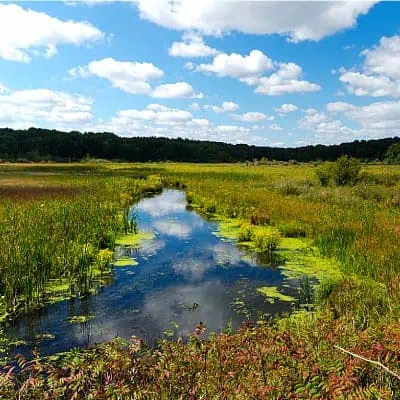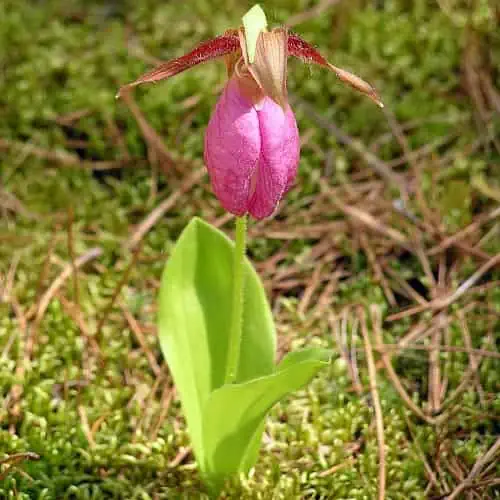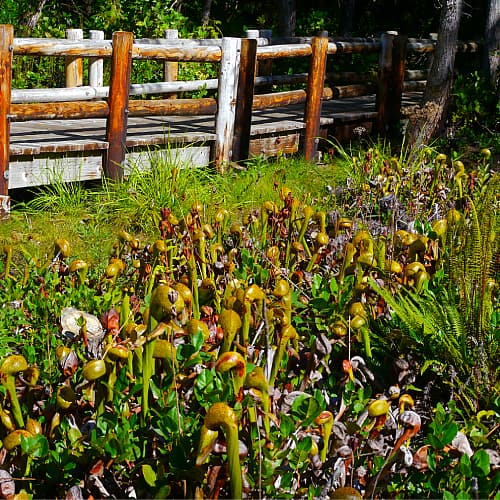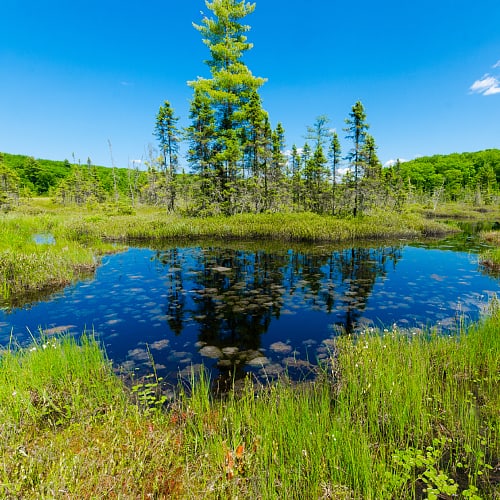
Fens are palustrine wetlands characterized by alkaline, often mineral-rich soils, though fens can also be somewhat acidic depending on the type of soil or rock that the groundwater comes into contact with. They rely on groundwater for their moisture, often contain peaty soils (similar to bogs, which differ from fens in that they are nutrient-poor, always acidic, and rely on precipitation rather than groundwater), and often have small streams or brooks running through them.
They are typically formed in existing depressions with mineral-rich groundwater that is able to seep to the surface. In time, the depression builds up a layer of minerals and peat, which in turn hold in moisture. Over many thousands of years, this can become a fen.
As with most wetlands, the life found in fens is specialized to live in these unique, productive ecosystems. Oftentimes, these organisms are rare and can be found nowhere else on Earth. Though fens are most common in the northern hemisphere, particularly North America and portions of Europe and Asia, they can be found almost worldwide. As a result, organisms found in fens will, of course, differ depending on exact location and type of fen (a coastal fen versus prairie fen, for example).
The plants found in fens aid in important tasks like flood control, water filtration, soaking up excess pollutants and nutrient runoff that would otherwise adversely impact other ecosystems and human water sources, and providing a multitude of animals with food and shelter. Peatlands (the collective term for bogs and fens) are able to sequester more carbon than any other vegetative ecosystem type in the world, making them invaluable carbon sinks that can aid in mitigating climate change.
Types of Fen Plants
Here, we will break down some of the most common types of plants found in fens, focusing on somewhat broad classifications, such as family and/or genus, rather than delving down to exact species level to help keep this list as relevant as possible regardless of location. As every fen can contain hundreds of plant species, this is by no means anywhere near an exhaustive list.
1) Herbaceous Plants
This category contains graminoids (grasses and grass-like plants, including sedges) and forbs (herbaceous flowering plants other than grasses). This group is by far the most dominant among all fen types.
Flowers

Some flower types that you can expect to find in most fens include a variety of asters (Symphyotrichum), goldenrods (Solidago), lady-slippers (Cypripedium), St. John’s-wort (Triadenum), irises such as blue-flag and yellow iris (Iris), and many, many others, including some endangered orchid species. These can include, subject to the type and location of the fen, bog buckbean (Menyanthes trifoliata), wood anemone and bog anemone (Anemone), cinquefoils (Comarum), meadow rues (Thalictrum), bonesets (Eupatorium), skullcaps (Scutellaria), a variety of lobelias (Lobelia), and a several species of mints (Lamiaceae).
Carnivorous Plants

Though often expected to grow in bogs due to being well-adapted to acidic conditions, some sundew (Drosera) and pitcher plant (Sarracenia) species can be found in fens. The most common species in fens include the round-leaved sundew (Drosera rotundifolia) and the purple pitcher plant (Sarracenia purpurea). These are most commonly found in more acidic and peaty fens, or even poor fens with sections of peat accumulation, but can even be found in some calcium-rich, alkaline fens such as coastal fens where peaty marl flats are able to occur and a very thin layer of soil nutrients make carnivorous plants especially well-suited, as they are able to obtain their own nutrients via insects.
Grasses (Poaceae family)
Grasses are quite common around the edges and higher points of fens. The grass family, Poaceae, is one of the largest flowering plant families, containing over 10,000 species and some seven hundred genera! As such a massive and difficult to study family, we won’t attempt the feat of breaking it down to specific genera or species. As such a huge plant community, it’s no surprise that hundreds of species are well adapted to living life in all types of fens around the world.
Rushes (Juncus species)
Belonging to the family Juncaceae, with true rushes categorized into the genus Juncus numbering around three hundred species, rushes are also incredibly common in fens. They have noticeably round stems, and often possess hollow leaf bases that can hold water should a drought occur. Rushes are known for being quite variable, making them capable of colonizing a variety of habitats, but most prefer moist wetland habitats such as fens. Rushes are most commonly found in the “flarks” of fens, otherwise known as the hollows or low points with more saturation.
Sedges (Carex species)

Sedges are typically the most common plant type in fens, regardless of exact fen type or location. Belonging to the family Cyperaceae with true sedges numbering over 2,000 species in the genus Carex alone, sedges appear somewhat like grasses at first glance but have a few distinct features. They are typically three-sided, with a popular botany adage helping us to remember, “sedges have edges” in reference to being able to see and feel their triangular edges on the primary stem. Their leaves, unlike grasses, are not jointed but occur each as a singular leaf attached to the main stem. When flowering, they have somewhat spike-like clusters of dense, tiny flowers and seeds atop their main stem.
Sedges are quite hardy, and well-adapted to life in a moist fen wetland. As fens mostly occur in the northern hemisphere, sedges are also well-suited to short growing seasons and long winters. They are often found growing in what are known as the “strings” of fens, or the more peaty higher portions that aren’t as saturated with water.
2) Shrubs

Shrubs are woody vegetation that differ from trees in that they are small (under ten meters) and have multiple primary stems as opposed to just one. A multitude of shrubs can be found in fens, again depending on the type of fen. Small, shrubby willows like bog willow (Salix pedicellaris) and sage willow (Salix candida) can be found in North American fens, with a variety of alder (Alnus), dogwood (Cornus), juniper (Juniperus), buckthorn (Rhamnus), and small birch (Betula) species being found in many fens in Europe, Asia, and North America.
Many fruiting species can be found in bogs, as well, providing ample food for birds, mammals, and herpetofauna like turtles alike. These can include cranberry and blueberry (Vaccinium) species, raspberries and cloudberries (Rubus), holly (Ilex), laurels like bog laurel (Ilex polifolia), and chokeberries (Aronia; named for their bitter taste, as they’re not toxic), among others.
3) Trees

In fens, the most common trees include tamaracks (Larix species), spruces (Picea species), cedars (Thuja species), and some pines (Pinus species). All of these are well-adapted to damp, neutral to alkaline conditions. They can exist sporadically within the fen itself, but most often occur in island-like clumps on raised land within the fen or more thickly along the edges. Trees are the least abundant plant type in fens, typically covering less than 10% of the area.
4) Other Species
Ferns and mosses are typically fairly plentiful in fens, though exact species can depend on whether the fen is considered to be rich (peaty), poor (calcareous, or calcium-rich), or somewhere in between.
Among rich fens, sphagnum mosses and other peat mosses are more common. These often form hummocks, or small, pillowy humps, that a variety of wildlife can utilize for shelter. Species of fern such as sensitive fern, royal fern, and marsh fern can also be found. Among more poor fens, brown mosses and scorpidium mosses are often more common, though some sphagnums may still be found (there nearly four hundred species of sphagnum!).
Equisetum species, also known as horsetails and scouring rushes, are common regardless of fen location or type, able to be found in many southern as well as northern hemisphere fens. Equisetums are visually and biologically unique and prehistoric plants, considered to be living fossils as Equisetum is the only surviving genus of the horsetail family dating back some 350 million years ago!
These plants are hollow and segmented, meaning that they can hold water and thus survive periods of even extreme drought, and segments can break off cleanly so that herbivory from animals like deer will not usually kill them.

